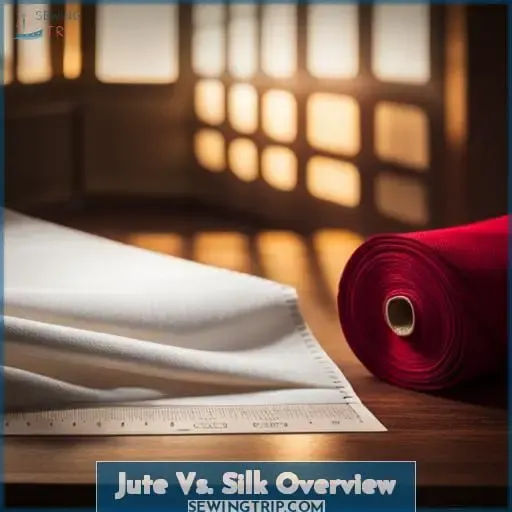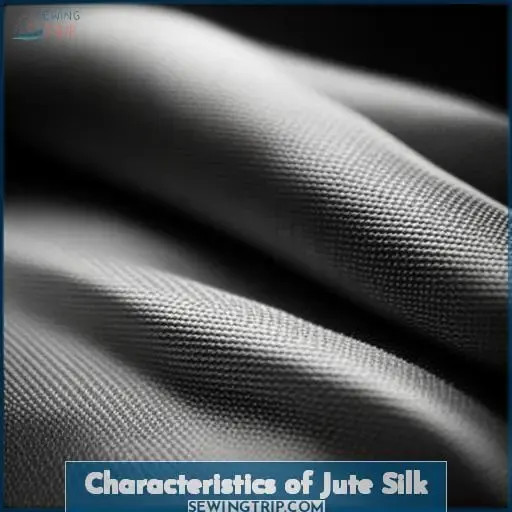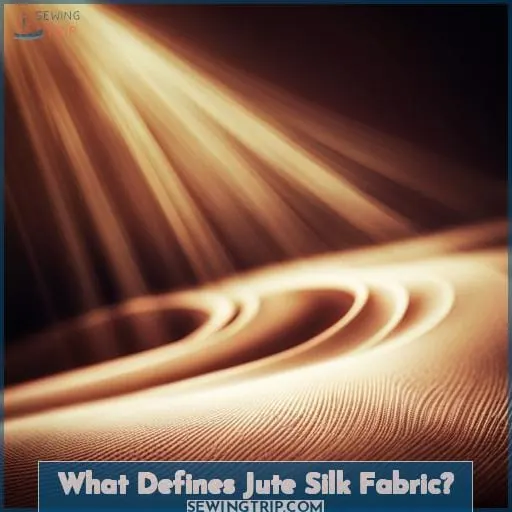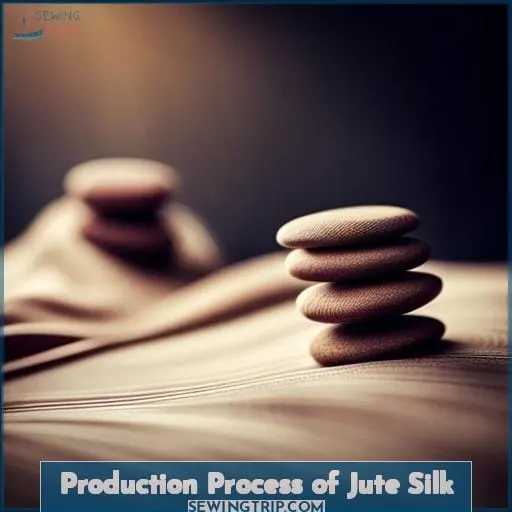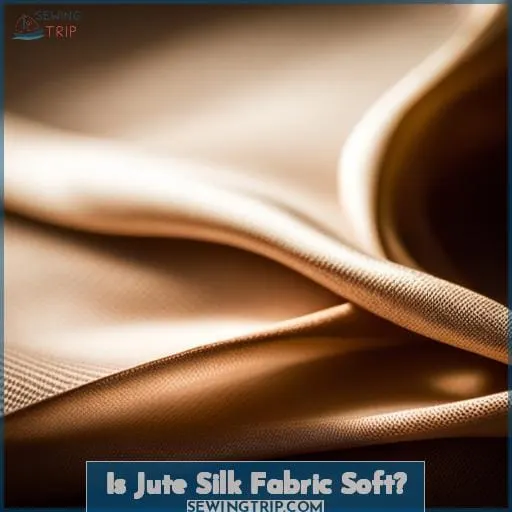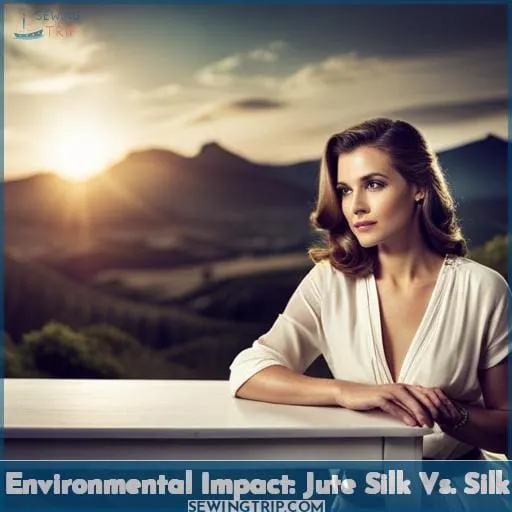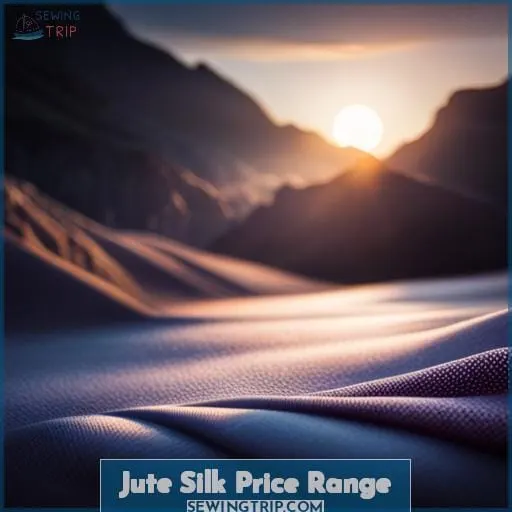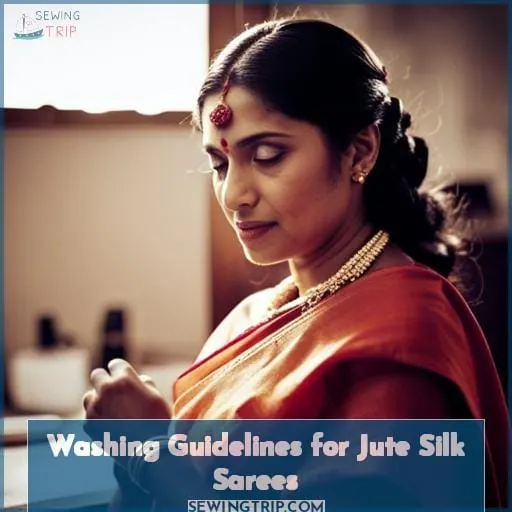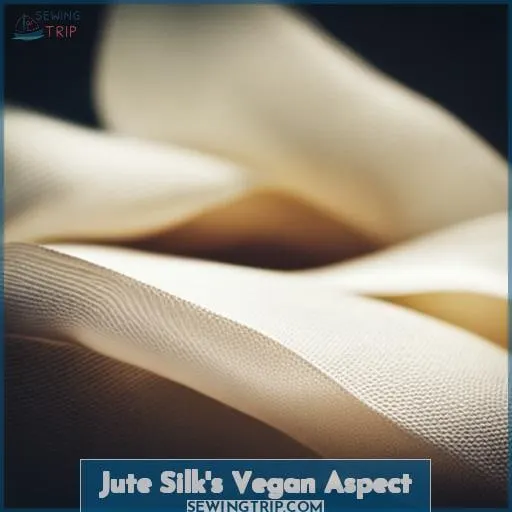This site is supported by our readers. We may earn a commission, at no cost to you, if you purchase through links.
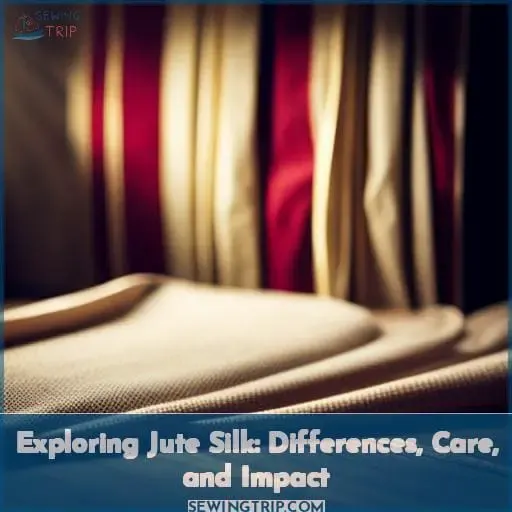 Unlock the intricate world of jute silk fabric and unravel its nuanced differences from traditional silk.
Unlock the intricate world of jute silk fabric and unravel its nuanced differences from traditional silk.
Delve into its textural contrast, manufacturing specifics, and distinct care rituals.
Understand its plant-based origins and the environmental impact it wields against conventional silk.
Explore its price range and where to find this versatile material.
Discover the unique blend of liberation and eco-conscious power packed within jute silk.
Table Of Contents
- Key Takeaways
- Jute Vs. Silk Overview
- Characteristics of Jute Silk
- What Defines Jute Silk Fabric?
- Production Process of Jute Silk
- Is Jute Silk Fabric Soft?
- Environmental Impact: Jute Silk Vs. Silk
- Jute Silk Price Range
- Where to Find Jute Silk
- Washing Guidelines for Jute Silk Sarees
- Jute Silk’s Vegan Aspect
- Frequently Asked Questions (FAQs)
- Conclusion
Key Takeaways
- Jute silk is a blend of jute and silk fibers.
- Jute silk is soft and lustrous.
- Jute silk is durable and sustainable.
- Jute silk is affordable.
Jute Vs. Silk Overview
When comparing jute and silk, striking differences emerge in their origins and textures, shaping their distinct cultural significance and applications in varied fabric compositions.
Jute, derived from plant fibers, embodies durability and sustainability, making it a favored choice for sustainable textiles. In contrast, silk, harvested from silkworms, epitomizes luxury and finesse with its soft, lustrous texture.
The contrast between these natural fibers extends to their varied applications. Jute, renowned for its robustness and versatility, finds its place in burlap and gunny sack materials, embodying strength and utility.
Conversely, silk, with its delicate and elegant nature, adorns luxurious garments and linens, symbolizing opulence and refinement.
Texturally, jute mimics the roughness of cotton and wool, while silk’s softness and shimmer create a unique allure. Understanding these distinct fabric properties empowers one to appreciate the diverse avenues where these materials can be utilized, from rustic, earthy designs to lavish, sophisticated creations.
The cultural significance of these fabrics reverberates across industries and regions, each fabric speaking volumes about tradition, craftsmanship, and the art of weaving stories through textiles. This comparison of jute and silk offers insight into the rich tapestry of fabric diversity, both in their origins and their varied applications across different cultures.
Characteristics of Jute Silk
When it comes to the characteristics of jute silk, there are a few key points to consider.
Firstly, jute silk offers a unique textural contrast compared to other fabrics like cotton and wool.
Additionally, the manufacturing process for jute silk differs from traditional silk production methods.
Lastly, caring for and maintaining jute silk may require different techniques than those used for regular silk fabric.
Textural Contrast
Transitioning from the comparison of Jute and Silk, delve into the unique characteristics of Jute Silk fabric, feeling its textures that mimic the blend of silk’s softness and jute’s natural roughness.
This amalgamation defines Jute Silk’s textile properties, showcasing weave variations that offer a distinct fiber feel.
The fabric’s surface differences reflect its fabric production methods, highlighting sustainable cultivation and the inherent benefits of a natural material.
Manufacturing Variance
The manufacturing variance of jute silk distinguishes it significantly from traditional silk, marking a notable evolution in fabric production techniques.
- Fiber Processing: Jute undergoes advanced processing methods, blending traditional craftsmanship with modern technology.
- Textile Technology: Innovative machinery refines jute fibers, enhancing their quality while preserving sustainability.
- Sustainable Practices: Emphasis on eco-friendly approaches in jute processing ensures organic materials and minimal environmental impact.
Care and Maintenance Differences
To maintain the allure and longevity of jute silk, prioritize careful laundering and attentive storage practices.
For stain removal, blot gently using a mild detergent solution, avoiding harsh chemicals.
Air drying in shade retains its texture and color vibrancy.
Fold jute silk sarees neatly and store in a breathable fabric or acid-free paper to prevent creasing.
These mindful steps not only preserve the fabric’s charm but also align with sustainable, eco-conscious practices.
What Defines Jute Silk Fabric?
Understanding jute silk begins with its distinctive composition—melding plant-derived jute fibers with other textile fibers. This fusion creates a fabric that embodies the strengths of both materials, resulting in a unique and sustainable elegance.
The defining characteristics of jute silk fabric can be summarized as follows:
- Textural Fusion: Jute silk combines the rough and natural appeal of jute fibers with the smoothness and lustrous texture reminiscent of traditional silks.
- Natural Appeal: Being derived from plants, jute silk fabric showcases its environmental consciousness by offering an eco-friendly alternative to synthetic fabrics. Its production process minimizes harm to nature while maintaining high-quality standards.
- Environmental Consciousness: Jute itself is known for being one of the most sustainable fiber crops due to its low water requirements, minimal pesticide use, and ability to enrich soil fertility naturally.
In summary, what defines jute silk fabric lies in its unique ability to combine different textures into one cohesive material while embodying sustainability at every step – from production methods that minimize environmental impact to the inherent qualities of jute fibers that contribute towards preserving our planet’s resources without compromising on style or comfort.
Production Process of Jute Silk
To understand how jute silk is produced, let’s take a closer look at the production process.
Jute silk fabric goes through several stages before it becomes the sustainable and versatile fabric we know.
The first stage is hand harvesting, where mature jute plants are carefully selected and harvested by skilled workers.
The next step is defoliation, which involves removing leaves from the harvested plants to prepare them for further processing.
After defoliation comes the retting process. This essential step helps eliminate non-fibrous materials from the jute fibers by soaking them in water or exposing them to dew for a specific period. Retting softens these fibers and makes it easier to separate them during subsequent stages.
Once retted, fiber separation takes place using various mechanical processes that comb out any remaining impurities and aligns the fibers into long strings ready for spinning into yarn.
Yarn spinning converts these prepared jute fibers into strong threads that can be woven or knitted into fabrics. Additionally, chemical enhancements may be applied during this stage to improve qualities like softness and durability of finished products made with jute silk fabric.
By understanding each step of its production process from hand harvesting all way through yarn spinning with potential chemical enhancements; you gain insight on why this unique textile holds such value as an environmentally friendly alternative known as ‘julee’ among enthusiasts seeking liberation within their fashion choices
Is Jute Silk Fabric Soft?
Feel the luxurious touch of Jute Silk against your skin as it boasts a surprising softness, a distinctive trait that sets it apart in the realm of textile fabrics. This softness stems from the meticulous processing of jute fibers during the production phase.
Jute, known for its coarse texture in its raw form, undergoes a series of treatments aimed at enhancing its tactile appeal. The fibers are carefully combed and spun into yarn, and chemical processes are employed to refine and soften the material.
This deliberate softening not only elevates the comfort factor but also creates a fabric that feels gentle against the skin.
In a comfort comparison with other fabrics, Jute Silk holds its ground admirably. While jute, in its natural state, mightn’t be synonymous with softness, the specialized treatment it undergoes transforms it into a textile that offers a unique blend of texture and wearable comfort.
The resulting tactile experience of Jute Silk fabric isn’t only pleasing but also challenges preconceived notions, making it a compelling choice for those who seek both style and comfort in their attire.
So, indulge in the soft embrace of Jute Silk, and experience a harmonious fusion of natural charm and tactile luxury.
Environmental Impact: Jute Silk Vs. Silk
When comparing the environmental impact of jute silk and silk, you’ll find that jute silk fabric outshines its counterpart in sustainability. Embracing eco-friendly choices and contributing to green fashion, jute silk stands as a commendable silk alternative with a lower fabric footprint.
Here are key considerations highlighting jute silk’s environmental stewardship:
-
Sustainable Textiles: Jute silk, derived from plant fibers, epitomizes the essence of sustainable textiles. Its production involves minimal environmental stress compared to traditional silk, which relies on silkworms and complex sericulture processes.
-
Fabric Footprint: Jute silk boasts a significantly reduced fabric footprint, aligning with the ethos of conscious consumerism. This sustainable choice minimizes the ecological impact associated with conventional silk production, making it an ethical fiber option.
-
Textile Certifications: Jute silk often comes with recognized textile certifications, reaffirming its commitment to ethical and sustainable practices. These certifications provide consumers with the assurance that their choice aligns with responsible and eco-conscious fashion.
-
Ethical Fibers: Choosing jute silk contributes to the promotion of ethical fibers in the fashion industry. By opting for this environmentally friendly alternative, you actively participate in shaping a more sustainable and responsible approach to textile consumption.
In the realm of eco-friendly choices, jute silk emerges as a beacon of green fashion, offering a compelling alternative with a positive impact on both style and the environment.
Jute Silk Price Range
Explore the affordability of Jute Silk, as it offers a cost-effective alternative to traditional silk fabrics, making it a budget-friendly choice for those seeking elegance without breaking the bank.
With its market trending popularity in sustainable fashion and designer collaborations, jute silk fabric is available in a wide range of prices, from affordable to high-end.
Jute silk sarees are typically more expensive than other types of jute silk garments, but they can still be found at a variety of price points.
You can find jute silk fabrics and garments online and in specialty stores.
Where to Find Jute Silk
With a price range of , jute silk is easily accessible and available in a variety of places.
- Online retailers
- Boutiques
- Sustainable brands
Washing Guidelines for Jute Silk Sarees
10 washing guidelines to keep your jute silk sarees looking their best:
| Washing Method | When to Use | Steps |
|---|---|---|
| Hand washing | For minor stains | Rinse with warm water and mild soap. Gently dab with a clean cloth to remove the stain. |
| Dry cleaning | For major stains or damage | Take your jute silk saree to a professional dry cleaner. |
| Spot cleaning | For small stains | Dab a small amount of mild soap on the stain with a clean cloth. Blot with a dry cloth to remove the soap. |
| Avoid bleach and harsh chemicals | Bleach and harsh chemicals can damage the fibers of jute silk. | |
| Air dry flat | Jute silk sarees should be air dried flat to prevent wrinkles. |
Keep these washing guidelines in mind to help your jute silk sarees last for years to come.
Jute Silk’s Vegan Aspect
Now that you know how to wash your jute silk sarees, you can be confident that you’re taking care of your garment in a way that’s both sustainable and vegan-friendly. Jute silk is made from plant-based fibers, so it doesn’t require any animal products to produce.
This makes it a great option for vegans and those who are looking for a sustainable fabric.
Here are 5 benefits of choosing jute silk:
- It’s breathable. Jute silk is a lightweight fabric that allows air to circulate, keeping you cool and comfortable.
- It’s hypoallergenic. Jute silk is a great choice for people with allergies or sensitivities, as it doesn’t cause irritation.
- It’s durable. Jute silk is a strong fabric that can withstand everyday wear and tear.
- It’s biodegradable. Jute silk is a natural fiber that will decompose when it’s disposed of properly.
- It’s vegan. Jute silk is made from plant-based fibers, so it’s a cruelty-free option for vegans.
If you’re looking for a sustainable, vegan, and breathable fabric, jute silk is a great choice.
Frequently Asked Questions (FAQs)
Can jute silk fabric be used for clothing other than sarees?
Jute silk fabric can be used for clothing other than sarees, such as:
- Tops
- Skirts
- Pants
- Dresses
It’s a breathable and durable fabric that’s perfect for warm weather.
How does the production process of jute silk differ from that of regular silk?
While jute and regular silk are both derived from plants, the production process of jute silk differs in that it doesn’t require the use of silkworms.
What are the environmental benefits of using jute silk fabric?
Jute silk is a plant-based fabric that’s biodegradable and environmentally friendly.
It’s also water-resistant and durable, making it a great choice for a variety of applications.
Are there any specific care instructions for washing jute silk sarees?
Jute silk sarees are best preserved by dry cleaning.
They’re lightweight and easy to drape, with pleats that stay intact.
Where can I find jute silk fabric for purchase?
Jute silk fabric is available for purchase online and in specialty stores.
Jute silk is a blend of jute and silk fibers, and is known for its durability, softness, and breathability.
Conclusion
Now that you have explored jute silk fabric, you can decide if this eco-friendly alternative to silk is the right choice for you.

